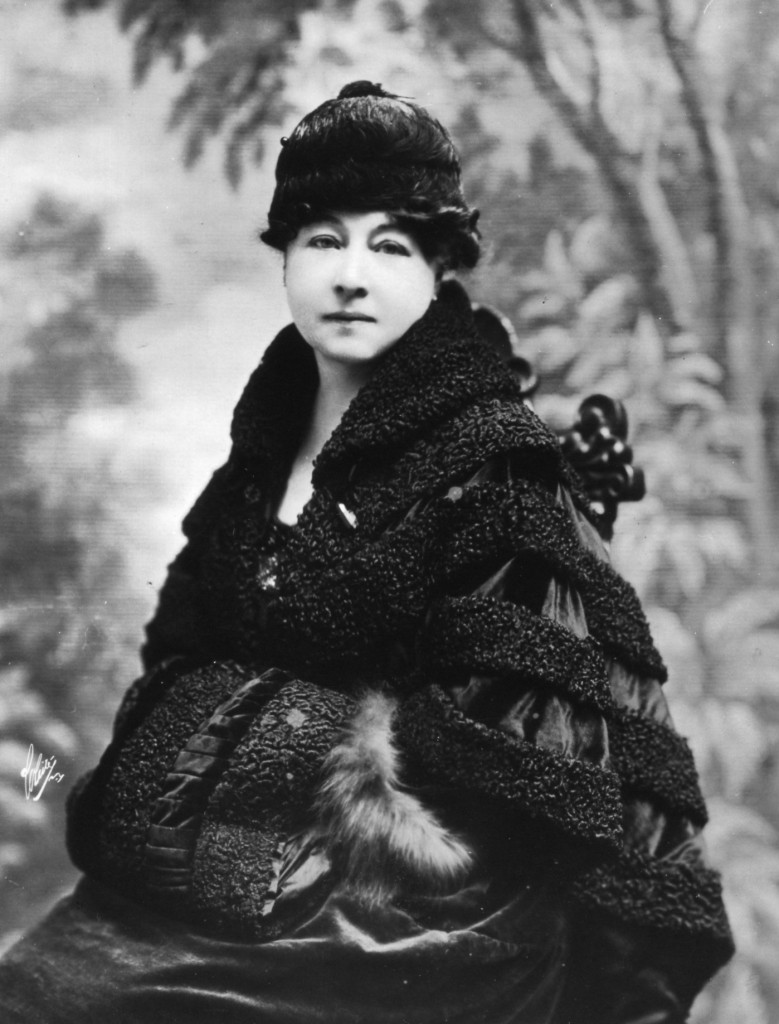by
Alison McMahan
From 1896 to 1906 Alice Guy was probably the only woman film director in the world. She had begun as a secretary for Léon Gaumont and made her first film in 1896. After that first film, she directed and produced or supervised almost six hundred silent films ranging in length from one minute to thirty minutes, the majority of which were of the single-reel length. In addition, she also directed and produced or supervised one hundred and fifty synchronized sound films for the Gaumont Chronophone. Her Gaumont silent films are notable for their energy and risk-taking; her preference for real locations gives the extant examples of these Gaumont films a contemporary feel. As Alan Williams has described her influence, Alice Guy “created and nurtured the mood of excitement and sheer aesthetic pleasure that one senses in so many pre-war Gaumont films, including the ones made after her departure from the Paris studio” (57). Most notable of her Gaumont period films is La Vie du Christ (1906), a thirty-minute extravaganza that featured twenty-five sets as well as numerous exterior locations and over three hundred extras.
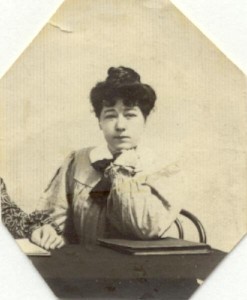
Alice Guy Blaché. Private Collection.
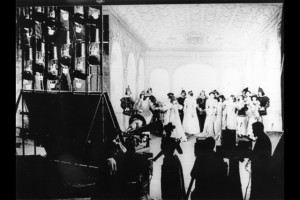
Alice Guy Blaché on set. Courtesy of the Academy of Motion Picture Arts and Sciences, Margaret Herrick Library.
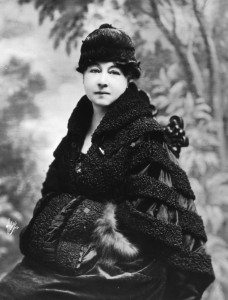
Alice Guy Blaché. Courtesy of the Royal Belgian Film Archive.
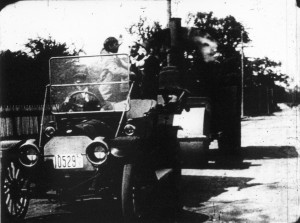
Matrimony’s Speed Limit (1915). Private Collection.
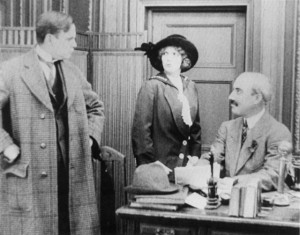
A House Divided (Solax, 1913). Private Collection.
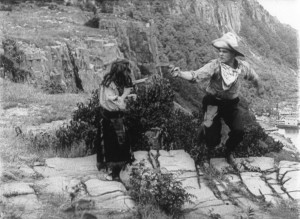
Two Little Rangers (Solax, 1912). Private Collection.
In early 1907, Guy resigned her position as head of Gaumont’s film production arm in Paris although she did not end her business relationship with Gaumont. She married Herbert Blaché, another Gaumont company employee. Léon Gaumont sent Herbert to Cleveland to start a Gaumont Chronophone franchise. After nine months the franchise failed, and Gaumont made Herbert manager of his New York studio in Flushing, Queens, which was originally built to produce English language chronophone films. Gaumont had an agreement with the Edison Company and the other members of the Motion Picture Patents Company (MPPC) that his company’s sound as well as silent motion pictures would be distributed as licensed films. In 1909, Edison, who planned his own synchronized sound device called the Kinetophone, began to resist the idea of including the Gaumont company as a licensed MPPC distributor. As a result of Edison’s influence, Gaumont’s many applications for formal membership in the MPPC were rejected. The Flushing plant languished.
In 1910, Guy decided to take advantage of the under-used Flushing plant. She started her own company, Solax, and made silent films using the Gaumont studio. The Solax films were then distributed by Gaumont through George Kleine’s distribution company. By 1911, Solax was making enough money for the Blachés to move into their own large house. Guy built a $100,000 studio plant for Solax in Fort Lee, New Jersey, in 1912, the same year her second child, Reginald, was born, brother to Simone, born in 1908. Once Gaumont, no longer part of the MPPC monopoly, joined the ranks of the independents, Solax had to negotiate for distribution on a state-by-state basis.
For the two years that it was successful, the Solax Company jump-started the careers of several actors and made stars out of performers such as Darwin Karr and Blanche Cornwall, who starred in a series of melodramas that critiqued the social system, such as A Man’s a Man (1912), The Roads That Lead Home (1913), The Girl in the Armchair (1913), and The Making of an American Citizen (1911) as well as action films like The Detective and His Dog (1912) and the multi-reeler The Pit and the Pendulum (1913). Karr and Cornwall also starred in comedies like A Comedy of Errors (1912), Canned Harmony (1912), His Double (1912), and Burstop Holmes’ Murder Case (1913). But the actors that really brought Guy’s comic genius to life were Marion Swayne and Fraunie Fraunholz. They starred in A House Divided (1913) and Matrimony’s Speed Limit (1913), two typical examples of Alice Guy’s emphasis on marriage as an equal partnership and the reason these two extant films still appeal to audiences today. Guy also made numerous action films with female characters as heroes, many of them starring Vinnie Burns. Guy first cast Burns when she was an unknown teenager, then trained her to do her own stunts in actions films such as Two Little Rangers (1912), Greater Love Hath No Man (1913), and Guy’s masterpiece at Solax, the three-reeler Dick Whittington and His Cat (1913), for which the director had a real boat detonated. Guy also gave Romaine Fielding his start as an actor; he appeared in numerous Solax films, including Mixed Pets (1911), Across The Mexican Line (1911), and Greater Love Hath No Man.
The Solax films that stand out today are Guy’s comedies of cross-dressing, such as the extant titles Cupid and the Comet (1911), starring Burns, and What Happened to Officer Henderson (1913), featuring Swayne and Fraunholz. There is also the lost film In the Year 2000 (1912), with Fraunholz and Cornwall, in which male and female gender roles are completely reversed. (Guy originally made the same film for Gaumont in 1906, entitled Les Résultats du féminisme, which survives.) The Solax Company provided a rich growth and learning environment for set designers like Ben Carré and Henri Ménessier, who had followed Alice Guy from Paris. Ménessier, who had designed the sets for Guy’s masterpiece at Gaumont, La Vie du Christ, wrote the photoplay and designed the sets for the Guy-produced film The Sewer (1912), directed by Edward Warren and starring Darwin Karr.
By 1913, the distribution difficulties began to make themselves felt. Solax moved from producing shorts to features the same year, while still producing shorts. However, by the end of 1913, it was clear that the day of the short film was over. Herbert started his own company, Blaché Features, Inc. Blaché Features used the Solax studio and often the same actors. However, Solax continued to work in parallel and some press announcements continued to use the Solax name for both companies for quite some time. Under the Blaché Features banner the couple took turns directing a feature film, or sometimes two, a month, each producing the films the other directed (Slide 74). Some of the films Guy directed include The Shadows of the Moulin Rouge (December 1913) and the following films in 1914: Beneath the Czar, The Dream Woman, The Monster and the Girl, The Woman of Mystery, and The Lure. The script for The Lure was based on the popular Shubert Theatrical production of the play by George Scarborough, and most of the cast from the play appeared in the film (“The Three Arts” 8). It was distributed by the World Corporation, which merged with the Shubert Organization just before the film was released (“World Film and Shuberts Combine” 29).
Blaché Features joined Popular Plays and Players, a loose coalition of film production companies. Under the Popular Plays and Players banner, Guy directed (all in 1915): Heart of a Painted Woman, The Vampire, My Madonna, and What Will People Say?, all starring Olga Petrova. She directed one final film under the Popular Plays and Players banner, The Empress, released on March 11, 1917 (“Features – Current and Coming” 1577), the only film of this period that still survives, though in fragmented form. Popular Plays and Players was absorbed into Metro, according to Billboard in 1917 (65).
Both Guy and Herbert worked as directors for hire in the teens. Guy directed The Ocean Waif for the Golden Eagle/International Film Service, owned by Hearst, which was released on November 2, 1916. On July 1, 1916, Motion Picture News announced that the couple would “shortly open the ‘Greater Blache [sic] Studios’ adjoining the present Solax-Blache [sic] stages and Produce for World and Pathe [sic]” (“Blache [sic] Will Pay $1,000 for Script” 4042). Her surviving feature from this period is the Marcus Loew production The Great Adventure (1918), starring Bessie Love, for which Agnes Christine Johnston wrote the screenplay. The couple separated and Herbert went to Hollywood, but had Guy join him there after she nearly died of the Spanish Influenza. There she worked as his assistant director on The Divorcee (Metro, 1919) starring Ethel Barrymore and two films produced by and starring Alla Nazimova: The Brat (1919) and Stronger than Death (1920). The couple divorced in 1920. Herbert remained in Hollywood and continued to direct features, including The Saphead (1920), starring Buster Keaton, until 1927. He remarried and became a furniture merchant. He died in 1953. In 1922, after handling the bankruptcy auction for her studio plant, Guy chose to return to France, where for the next thirty years she lectured widely on film and wrote magazine fiction and novelizations of film scripts. She never remarried, nor did she make another film. She died in New Jersey in 1968 and is buried in the Catholic cemetery in Mahwah, New Jersey. [Eds. This text was revised by the author in October 2018].
See also: Agnes Christine Johnston, Alla Nazimova, Olga Petrova
Alice Guy Blaché’s work in France will be thoroughly covered and included shortly.
Bibliography
Bachy, Victor. Alice Guy-Blaché (1873-1968): la première femme cinéaste du monde. Perpignan: Institut Jean Vigo, 1993.
The Billboard vol.6, no. 2 (1917): 65.
“Blache [sic] Enlarging Studio.” Moving Picture World (23 Nov. 1915): n.p.
“Blache [sic] Forms New Company. Will Be Known as United States Amusement Corporation and Will Make Big Features.” Moving Picture World (2 May 1914): 653.
“Blache [sic] Will Pay $1,000 for Script, If He Gets First Pick.” Motion Picture News (1 July 1916): 4042.
“Edward Warren Leaves Solax.” Moving Picture World (16 Aug. 1913): 725.
“Features - Current and Coming.” Motion Picture News (10 March 1917): 1577.
“A Forty-Five Minute Talking Picture.” Moving Picture World (24 May 1913): 801.
“Gaumont Talking Pictures.”New York Dramatic Mirror (31 Oct. 1908): 8.
Judson, J.K. “Kelly from the Emerald Isle: Barney Gilmore Plays His Well Known Role, ‘Kelly’ for the Solax Camera.” Moving Picture World vol. XVI, no. 9 (31 May 1913): 925.
“The Lure’ to Blaché Studio.” Moving Picture World (9 May 1914): 829.
MacDonald, M.I. “Madame Blaché’s Production of Auber’s Fra Diavolo.” Moving Picture News (15 June 1912): 18.
McMahan, Alison. Alice Guy Blaché: Lost Visionary of the Cinema. New York: Continuum, 2002.
------. Alice Guy Blaché: The Research and Books of Alison McMahan. http://www.aliceguyblache.com/
The Moving Picture World (23 Aug. 1913): 802-803. [Note: Blaché’s press release on pg. 804]
“The Pit and the Pendulum.” Ad. Moving Picture World (3 July 1913): 282-83.
Slide, Anthony, ed., The Memoirs of Alice Guy Blaché. Trans. Roberta and Simone Blaché. Metuchen, N.J.: The Scarecrow Press, 1986.
“The Solax Company.”Moving Picture News (15 July 1911): 14.
“Solax Company: What It Is Doing At the Studio” and “Mr. Wilbert Melville, Managing Director of the Solax Company.” Moving Picture News (17 June 1911): 8-9.
“The Three Arts.” The Evening Sun [Baltimore, MD] (14 May 1914): 8.
Williams, Alan. Republic of Images: A History of French Filmmaking. Cambridge: Harvard University Press, 1992.
“Will Pay $1,000 for Scenarios.” Moving Picture World (23 June 1916): 2250.
“World Film and Shuberts Combine.” Motography (4 July 1914): 29.
Filmography
A. Archival Filmography: Extant Film Titles:
1. Alice Guy Blaché as Director, Producer, and Screenwriter
Dick Whittington and His Cat. Prod./dir./sc.: Alice Guy Blaché (Solax Co. US 1913) si, b&w, 3 reels; 2825 ft. Archive: BFI National Archive.
2. Alice Guy Blaché as Producer and Director
Cupid and the Comet. Prod./dir.: Alice Guy Blaché (Solax Co. US 1911) si, b&w. Archive: Münchner Stadtmuseum.
Greater Love Hath No Man. Prod/dir.: Alice Guy Blaché (Solax Co. US 1911) si, b&w, 35 mm. Archive: Library of Congress, Cinémathèque Québécoise.
His Mother’s Hymn. Prod./dir.: Alice Guy Blaché (Solax Co. US 1911) si, b&w, 35 mm. Archive: UCLA Film & Television Archive.
Mixed Pets. Prod./dir.: Alice Guy Blaché (Solax Co. US 1911) si, b&w, 35 mm. Archive: Library of Congress.
Tramp Strategy. Prod./dir.: Alice Guy Blaché (Solax Co. US 1911) si, b&w. Archive: EYE Filmmuseum, Library of Congress.
Starting Something. Prod./dir.: Alice Guy Blaché (Solax Co. US 1911) si, b&w, 35 mm. Archive: Library of Congress.
Outwitted by Horse and Lariat. Prod./dir.: Alice Guy Blaché (Solax Co. US 1911) si, b&w. Archive: Bundesarchiv-Filmarchiv.
When Marian was Married. Prod./dir.: Alice Guy Blaché (Solax Co. US 1911) si, b&w, 35 mm. Archive: Library of Congress.
Across the Mexican Line. Prod./dir.: Alice Guy Blaché (Solax Co. US 1911) si, b&w, 16mm. Archive: Private Collection.
Broken Oaths. Prod./dir.: Alice Guy Blaché (Solax Co. US 1912) si, b&w. Archive: BFI National Archive.
Canned Harmony. Prod./dir.: Alice Guy Blaché (Solax Co. US 1912) cas.: Lee Beggs, Billy Quirk, Blanche Cornwall, si, b&w, 16mm. Archive: Library of Congress, Cineteca del Friuli, Lobster Films.
A Comedy of Errors. Prod./dir.: Alice Guy Blaché (Solax Co. US 1912) cas.: Darwin Karr, Billy Quirk, si, b&w, 944 ft. Archive: BFI National Archive.
The Detective’s Dog. Prod./dir.: Alice Guy Blaché (Solax Co. US 1912) cas.: Darwin Karr, Magda Foy, Blanche Cornwall, si, b&w, 35mm. Archive: Library of Congress, BFI National Archive.
Falling Leaves. Prod./dir.: Alice Guy Blaché (Solax Co. US 1912) cas.: Mace Greenleaf, Blanche Cornwall, Marian Swayne, si, b&w, 35mm. Archive: Library of Congress, Library and Archives Canada.
Fight in the Dark. Prod./dir.: Alice Guy Blaché (Solax Co. US 1912) si, b&w, 574ft. Archive: BFI National Archive.
A Fool and His Money. Prod./dir.: Alice Guy Blaché (Solax Co. US 1912) cas.: James Russell, si, b&w, 35mm. Archive: Library of Congress.
For Love of the Flag. Prod./dir.: Alice Guy Blaché (Solax Co. US 1912) cas.: Darwin Karr, Blanche Cornwall, Lee Beggs, Magda Foy, si, b&w, 35mm. Archive: Library of Congress.
The Girl in the Arm-Chair. Prod./dir.: Alice Guy Blaché (Solax Co. US 1912) si, b&w, 35mm, 16mm. Archive: Library of Congress, Academy Film Archive, Cineteca del Friuli, Lobster Films.
The High Cost of Living. Prod./dir.: Alice Guy Blaché (Solax Co. 1912) si, b&w, 35mm. Archive: UCLA Film & Television Archive.
Making an American Citizen. Prod./dir.: Alice Guy Blaché (Solax Co. 1912) si, b&w, Archive: UC Berkeley Art Museum & Pacific Film Archive, UCLA Film & Television Archive, Lobster Films.
A Man’s a Man. Prod./dir.: Alice Guy Blaché (Solax Co. US 1912) si, b&w, 35mm. Archive: George Eastman Museum.
The New Love and the Old. Prod./dir.: Alice Guy Blaché (Solax Co. 1912) cas.: Darwin Karr, si, b&w, 35mm. Archive: Library of Congress.
The Sewer. Prod./dir.: Alice Guy Blaché (Solax Co. US 1912) si, b&w, 35mm. Archive: Library of Congress.
Someone’s Luck Society. Prod./dir.: Alice Guy Blaché (Solax Co. US 1912) si, b&w. Archive: Museum of Modern Art.
The Strike. Prod./dir.: Alice Guy Blaché (Solax Co. US 1912) si, b&w, 900ft. Archive: BFI National Archive.
Two Little Rangers/The Little Rangers. Prod./dir.: Alice Guy Blaché (Solax Co. US 1912) si, b&w, 736 ft. Archive: BFI National Archive, EYE Filmmuseum.
God Disposes. Prod./dir.: Alice Guy Blaché (Solax Co. US 1912) cas.: Mace Greenleaf, Darwin Karr, Blanche Cornwall, Magda Foy, si, b&w. Archive: EYE Filmmuseum.
A Severe Test. Prod./dir.: Alice Guy Blaché (Solax Co. US 1913) si, b&w, 16mm. Archive: Private Collection.
Burstop Holmes’ Murder Case. Prod./dir.: Alice Guy Blaché (Solax Co. US 1913) si, b&w. Archive: EmGee Film Library.
The Coming of Sunbeam. Prod./dir.: Alice Guy Blaché (Solax Co. US 1913) si, b&w. Archive: Library of Congress.
His Double. Prod./dir.: Alice Guy Blaché (Solax Co. US 1913) si, b&w. Archive: EmGee Film Library.
A House Divided. Prod./dir.: Alice Guy Blaché (Solax Co. US 1913) si, b&w, 35mm, 16mm. Archive: Library of Congress, Cineteca del Friuli, BFI National Archive, UC Berkeley Art Museum & Pacific Film Archive, Lobster Films, Museum of Modern Art.
Napoleon. Prod./dir.: Alice Guy Blaché (Solax Co. US 1913) cas.: Darwin Karr, Blanche Cornwall, Billy Quirk, si, b&w, 35mm. Archive: Library of Congress.
Officer Henderson/What Happened to Henderson. Prod./dir.: Alice Guy Blaché (Solax Co. 1913) si, b&w. Archive: Lobster Films.
The Roads That Lead Home/Roads Lead Home. Prod./dir.: Alice Guy Blaché (Solax Co. US 1913) si, b&w, 35mm. Archive: Library of Congress.
The Thief. Prod./dir.: Alice Guy Blaché (Solax Co. US 1913) si, b&w. Archive: BFI National Archive.
Mr. Bruce Wins at Cards. Prod.: Herbert Blaché, Alice Guy Blaché, dir.: Alice Guy Blaché (Solax, 1914) si, b&w. Archive: BFI National Archive.
The Ocean Waif. Prod./dir.: Alice Guy Blaché, sc.: Frederick Chapin (Golden Eagle Pictures US 1916) cas.: Carlyle Blackwell, Doris Kenyon, si, b&w, 35mm, 5 reels. Archive: Library of Congress.
3. Alice Guy Blaché as Director and Co-Producer
The Pit and the Pendulum. Prod.: Herbert Blaché, Alice Guy Blaché, dir.: Alice Guy Blaché (Solax Co. US 1913) cas.: Darwin Karr, Fraunie Fraunholz, Blanche Cornwall, si, b&w, 35mm. Archive: Library of Congress, Museum of Modern Art, Library and Archives Canada.
Matrimony’s Speed Limit. Prod: Herbert Blaché, Alice Guy Blaché. Dir.: Alice Guy Blaché (Solax Co. US 1913) si, b&w, 35mm, 16mm. Archive: Library of Congress, Cineteca del Friuli, National Film and Sound Archive of Australia, Lobster Films, UC Berkeley Art Museum & Pacific Film Archive.
4. Alice Guy Blaché as Director and Co-Screenwriter
The Empress. Dir.: Alice Guy Blaché, sc.: Alice Guy Blaché, Holbrook Blinn (Popular Plays and Players US 1917) cas.: William Morse, Lynn Donaldson, Doris Kenyon, si, b&w, 5 reels. Archive: Cinémathèque Française.
5. Alice Guy Blaché as Director
The Vampire. Dir.: Alice Guy Blaché, sc.: Olga Petrova (Popular Plays and Players US 1915) cas.: Olga Petrova, si, b&w, 35mm, 5 reels. Archive: George Eastman Museum. Library of Congress.
The Great Adventure/Her Great Adventure/Spring of the Year. Dir.: Alice Guy Blaché, sc.: Agnes Christine Johnston (Pathé US 1918) cas.: Bessie Love, Chester Barnett, Flora Finch, si, b&w, 5 reels. Archive: BFI National Archive.
6. Alice Guy Blaché as Producer and Screenwriter
Beasts of the Jungle. Prod./aut.: Alice Guy Blaché, dir.: Edward Warren (Solax Co. US 1913) si, b&w, 3 reels. Archive: George Eastman Museum.
7. Alice Guy Blaché as Producer
Algie the Miner. Prod. Alice Guy Blaché, dir.: Edward Warren, Harry Shenck (Solax Co. US 1912) cas.: Billy Quirk, si, b&w, 35 mm. Archive: Library of Congress.
8. Alice Guy Blaché as Co-Producer
Brennan of the Moor. Prod.: Alice Guy Blaché, Herbert Blaché, dir.: Edward Warren (Solax Co. US 1913) si, b&w, 3 reels. Archive: Library of Congress, EYE Filmmuseum.
B. Filmography: Non-Extant Film Titles:
1. Alice Guy Blaché as Producer and Director for Solax Co.
A Child’s Sacrifice, 1910; A Fateful Gift, 1910; Her Father’s Sin, 1910; Lady Betty’s Strategy, 1910; Mrs Richard Dare, 1910; One Touch of Nature, 1910; The Pawnshop, 1910; The Sergeant’s Daughter, 1910; Two Suits, 1910; What is to Be, Will Be, 1910; A Widow and Her Child, 1910; All Aboard for Reno, 1911; The Altered Message, 1911; Baby Needs Medicine, 1911; Baby’s Choice, 1911; Baby’s Rattle, 1911; The Bachelor’s Housekeeper, 1911; A Bad Egg, 1911; Beneath the Moon, 1911; The Best Policy, 1911; Between Life and Death, 1911; A Breezy Morning, 1911; Bridget the Flirt, 1911; A Bum and a Bomb, 1911; Caribou Hunting, 1911; Corinne in Dollyland, 1911; A Corner in Criminals, 1911; A Costly Pledge, 1911; The Count of No Account, 1911; Cupid and the Comet, 1911; Cupid’s Victory, 1911; A Daughter of the Navajo, 1911; Deaf and Dumb, 1911; The Devil in a Tin Cup, 1911; The Divided Ring, 1911; The Double Elopement, 1911; The Fascinating Widow, 1911; Fickle Bridget, 1911; Following Cousin’s Footsteps, 1911; For Big Brother’s Sake, 1911; A Gay Bachelor, 1911; The Girl and the Bronco Buster, 1911; The Girl and the Burglar, 1911; Grandmother Love, 1911; Hector’s Inheritance, 1911; Her Uncle’s Will, 1911; A Heroine of the Revolution, 1911; Highlands of New Brunswick, Canada, 1911; A Hindu Prince, 1911; His Best Friend, 1911; His Better Self, 1911; His Mother’s Hymn, 1911; His Sister’s Sweetheart, 1911; His Wife’s Insurance, 1911; The Hold-Up, 1911; The House of Peace, 1911; How Hopkins Raised the Rent, 1911; Husbands Wanted, 1911; In the Nick of Time, 1911; An Interrupted Elopement, 1911; An Italian’s Gratitude, 1911; Johnnie Waters the Garden, 1911; Let No Man Put Asunder, 1911; Life on Board a Battleship, 1911; The Little Flower Girl, 1911; The Little Kiddie Mine, 1911; The Little Shoe, 1911; Love, Whiskers, and Letters, 1911; A Lover’s Ruse, 1911; Love’s Test, 1911; A Maid’s Revenge, 1911; Marked for Life, 1911; A Marvelous Cow, 1911; A Mexican’s Girl’s Love, 1911; A Midnight Visitor, 1911; The Mill of the Gods, 1911; Naval Review, 1911; Nearly a Hero, 1911; Nellie’s Soldier, 1911; Never Too late to Mend, 1911; The Nightcap, 1911; An Officer and a Gentleman, 1911; Oh! You Stenographer!, 1911; The Old Excuse, 1911; Out of the Arctic, 1911; Out of the Depths, 1911; A Package of Trouble, 1911; The Patched Shoe, 1911; The Paper Making Industry, 1911; Percy and His Squaw, 1911; The Phony Ring, 1911; Put Out, 1911; A Reporter’s Romance, 1911; A Revolutionary Romance, 1911; Ring of Love, 1911; The Rose of the Circus, 1911; Salmon Fishing in Canada, 1911; The Scheme that Failed, 1911; Sensible Dad, 1911; Sergeant Dillon’s Bravery, 1911; Sergeant Mann’s Bravery, 1911; She Was Not Afraid, 1911; The Silent Signal, 1911; The Somnambulist, 1911; A Terrible Catastrophe, 1911; That June Bug, 1911; Their First Baby, 1911; A Troublesome Picture, 1911; The Violin Maker of Nuremberg, 1911; The Voice of His Conscience, 1911; When Reuben Came to Town, 1911; The Will of Providence, 1911; At the Phone, 1912; Auto-Suggestion, 1912; The Bachelor’s Club, 1912; Bessie’s Suitors, 1912; Between Two Fires, 1912; Billie’s Troublesome Grip, 1912; Billy Boy, 1912; Billy, the Detective, 1912; Billy’s Insomnia, 1912; Billy’s Nurse, 1912; Billy’s Shoes, 1912; Black Sheep, 1912; Blighted Lives, 1912; The Blood Stain, 1912; The Boarding House, 1912; Bottles, 1912; Buddy and his Dog, 1912; By the Hand of a Child, 1912; The Call of the Rose, 1912; The Child of the Tenements, 1912; Count Henri, The Hunter, 1912; Mrs. Cranston’s Jewels, 1912; The Dog-Gone Question, 1912; Economical Brown, 1912; The Face at the Window, 1912; Father and the Boys, 1912; The Finger Prints, 1912; The Fixer Fixed, 1912; Flesh and Blood, 1912; The Flour Flush Actor, 1912; Four Friends, 1912; Frozen on Love’s trail, 1912; The Fugitive, 1912; The Glory of Light, 1912; The Gold Brick, 1912; The Great Discovery, 1912; A Guilty Conscience, 1912; Handle with Care, 1912; The Hater of Women , 1912; Hearts Unknown, 1912; His Lordship’s White Feather, 1912; His Musical Soul, 1912; Hotel Honeymoon, 1912; Hubby Does the Washing, 1912; The Idol Worshipper, 1912; Imagination, 1912; In the Year 2000, 1912; Indian Summer, 1912; The Jenkins-Perkins War, 1912; Just a Boy, 1912; Just Hats, 1912; The Knight in Armor, 1912; The Legend of the Balanced Rock, 1912; Lend Me Your Wife, 1912; The Life of a Rose, 1912; The Little Soldier, 1912; Love’s Railroad, 1912; The Maverick, 1912; Memories of ’49, 1912; Mignon, 1912; The Old Violin, 1912; Open to Proposals, 1912; Our Poor Relations, 1912; The Paralytic, 1912; Phantom Paradise, 1912; The Pink Garters, 1912; Planting Time, 1912; Playing Trumps, 1912; The Power of Money, 1912; The Prodigal Wife, 1912; A Question of Hair, 1912;The Raffle, 1912; The Reformation of Mary, 1912; The Report From Eden, 1912; The Requital, 1912; Riding Feats of the 15th Cavalry, 1912; Saved by a Cat, 1912; Sealed Lips, 1912; Slippery Jim, 1912; Si’s Surprise Party, 1912; The Snowman, 1912; The Soul of The Violin, 1912; Souls in the Shadow, 1912; The Spry Spinsters, 1912; A Terrible Lesson, 1912; Treasures on the Wing, 1912; Winsome But Wise, 1912; The Wise Witch of Fairyland, 1912; The Woman Behind the Man, 1912; The Wonderful Oswego Falls, 1912; The Wooing of Alice, 1912; The Amateur Highwayman, 1913; The Bachelor’s Housekeeper, 1913; The Bashful Boy, 1913; Burstop Holmes, Detective, 1913; Canine Rivals, 1913; The Case of the Missing Girl, 1913; The Climax, 1913; Cousins of Sherlock Holmes, 1913; Dad’s Orders, 1913; The Eyes of Satan, 1913; The Henpecked Burglar, 1913; His Son-in-Law, 1913; His Wife’s Affinity, 1913; In the Wrong Flat, 1913; The King’s Messenger, 1913; The Kiss of Judas, 1913; The Lady Doctor, 1913; The Man in the Sick Room, 1913; The Man who Failed, 1913; A Million Dollars, 1913; The Monkey Accomplice, 1913; Mother and Daughter, 1913; The Mutiny of Mr. Henpeck, 1913; The Mystery of the Lost Cat, 1913; The Ogres, 1913; Overcoats, 1913; The Past Forgiven, 1913; The Plan of the House, 1913; The Quarrelers, 1913; The Rogues of Paris, 1913; The Scheming Woman, 1913; The Silver Cross, 1913; Till the Day Breaks, 1913; The Way of the Transgressor, 1913; Where Love Dwells, 1913; The Wrong Box, 1913.
2. Alice Guy Blaché as Director, Screenwriter, and Co-Producer with Herbert Blaché for Solax Co. and Blaché Features, Inc.
Shadows of the Moulin Rouge, 1913; Beneath the Czar, 1914; The Dream Woman, 1914; The Lure, 1914; The Monster and the Girl, 1914; The Tigress, 1914; The Woman of Mystery, 1914.
3. Alice Guy Blaché as Director, Screenwriter, and Co-Producer with Herbert Blaché for U.S. Amusement Corporation
House of Cards, 1917; A Man and the Woman, 1917.
4. Alice Guy Blaché as Director and Co-Producer with Herbert Blaché for Solax Co. and Blaché Features, Inc.
As the Bell Rings, 1913; As Ye Sow, 1913; Ben Bolt, 1913; Blood and Water, 1913; A Child’s Intuition, 1913; The Coat That Came Back, 1913; Cooking for Trouble, 1913; Dooley and His Dog, 1913; A Drop of Blood, 1913; The Dynamited Dog, 1913; Falsely Accused, 1913; Fisherman’s Luck, 1913; The Flea Circus, 1913; Four Fools and A Maid, 1913; Gratitude, 1913; Gregory’s Shadow, 1913; Handcuffed for Life, 1913; The Heavenly Widow, 1913; Her Mother’s Picture, 1913; The Hopes of Belinda, 1913; The Intruder, 1913; Invisible Ink, 1913; Ish Ga Bibble, 1913; The Lame Man, 1913; The Little Hunchback, 1913; The Merry Widow, 1913; Men and Muslin, 1913; The Message to Heaven, 1913; The Quality of Mercy, 1913; Retribution, 1913; Romeo in Pajamas, 1913; The Smuggler’s Child, 1913; The Soul of Man, 1913; Strangers from Nowhere, 1913; Tale of a Cat, 1913; A Terrible Night, 1913; That Dog, 1913; True Hearts, 1913; Western Love, 1913; When the Tide Turns, 1913; An Unexpected Meeting, 1913.
5. Alice Guy Blaché as Director and Producer for Popular Plays and Players
The Vampire, 1915.
6. Alice Guy Blaché as Director and Co-Producer with Herbert Blaché for Popular Plays and Players
What Will People Say?, 1916.
7. Alice Guy Blaché as Director and Co-Producer with Herbert Blaché for U.S. Amusements Corporation
The Adventurer, 1917; Behind the Mask, 1917.
8. Alice Guy Blaché as Director and Screenwriter
The Heart of a Painted Woman, 1915; My Madonna, 1915; Tarnished Reputations, 1920.
9. Alice Guy Blaché as Producer and Screenwriter
Kelly from the Emerald Isle, 1913.
10. Alice Guy Blaché as Producer for Solax Co.
An Enlisted Man’s Honor, 1911; The Mascot of Troop “C”, 1911; The Stampede, 1911; The Equine Spy, 1912; Mickey’s Pal, 1912.
11. Alice Guy Blaché as Co-Producer with Herbert Blaché as Director for Blaché Features
A Fight for Millions, 1913; The Fortune Hunters, 1913; A Prisoner in the Harem, 1913; The Star of India, 1913; The Million Dollar Robbery, 1914.
12. Alice Guy Blaché as Co-Producer with Herbert Blaché as Director for Popular Plays and Players
The Shooting of Dan McGrew, 1915; Barbara Frietchie, 1915; The Song of the Wage Slave, 1915.
13. Alice Guy Blaché as Co-Producer with Herbert Blaché for Popular Plays and Players
The Ragged Earl, 1914; The Black Butterfly, 1916; The Devil at his Elbow, 1916; The Eternal Question, 1916; Extravagance, 1916; The Iron Woman, 1916; The Lure of a Heart’s Desire, 1916; Playing with Fire, 1916; The Scarlet Woman, 1916; The Soul Market, 1916; The Spell of the Yukon, 1916; The Weakness of Strength, 1916; Bridges Burned, 1917; The Secret of Eve, 1917.
14. Alice Guy Blaché as Assistant Director to Herbert Blaché
The Brat, 1919; The Divorcée, 1919; Stronger than Death, 1920.
C. DVD Sources:
Early Women Filmmakers: An International Anthology. DVD. (Flicker Alley US 2017) - contains Les Chiens Savants (1902), Une Histoire Roulante (1906), La Barricade (1907), Falling Leaves (1912), Making an American Citizen (1912), and The Girl in the Armchair (1912).
Pioneers: First Women Filmmakers. DVD/Blu-ray. (Kino Lorber US 2018) - contains Mixed Pets (1911), Tramp Strategy (1911), Greater Love Hath No Man (1911), Algie the Miner (1912), Falling Leaves (1912), The Little Rangers (1912), Canned Harmony (1912), A Fool and His Money (1912), The High Cost of Living (1912), The Coming of Sunbeam (1913), Burstup Homes' Murder Case (1913), A House Divided (1913), Matrimony's Speed Limit (1913), The Ocean Waif (1916), and other special features.
Les Pionnières du Cinéma. DVD/Blu-ray. (Lobster Films France 2018) - contains Greater Love Hath No Man (1911), Falling Leaves (1912), A Fool and His Money (1912), Algie the Miner (1912), For Love of the Flag (1912), Making an American Citizen (1912), The Girl in the Armchair (1912), Matrimony's Speed Limit (1913), and The Ocean Waif (1916)
Early Women Filmmakers 1911-1940. DVD/Blu-ray. (BFI UK 2019) - Greater Love Hath No Man (1911), Falling Leaves (1912), Algie the Miner (1912), Making an American Citizen (1912), The Girl in the Armchair (1912), Matrimony's Speed Limit (1913), The Ocean Waif (1916).
Alice Guy-Blaché vol. 1: The Gaumont Years. DVD/Blu-ray (Kino Lorber US 2020)
Alice Guy-Blaché vol. 2: The Solax Years. DVD/Blu-ray (Kino Lorber US 2020)
The Movies Begin. DVD box set. (Kino Lorber US 2002)- contains Making an American Citizen (1912)
The Ocean Waif. DVD. (Kino Lorber US 2008)
Origins of Film. DVD box set. (Image Entertainment US 2001)- contains A House Divided (1913) and Matrimony's Speed Limit (1913)
More Treasures from the American Film Archives. DVD box set. (Image Entertainment US 2004) - contains Falling Leaves (1912)
Gaumont Treasures Part 1. DVD box set. (Kino Lorber US 2009) - contains almost all extant films made in France.
Seven Silent Films: Lost for a Century. DVD. (American Media International 2012) - contains A Fool and His Money (1912)
Be Natural: The Untold Story of Alice Guy-Blaché. DVD. (Zeitgeist Films US 2019)
D. Streamed Media:
Across the Mexican Line (1911) available on Amazon Prime (through Harpodeon)
A Severe Test (1913) available on Amazon Prime (through Harpodeon)
Canned Harmony (1912) is streaming online via Kanopy
Falling Leaves (1912) is streaming online via Kanopy
Two Little Rangers (1912) is streaming online via EYE Filmmuseum (Dutch intertitles)
God Disposes (1912) is streaming online via EYE Filmmuseum (Dutch intertitles)
A House Divided (1913) is streaming online via Kanopy
The Ocean Waif (1916) is streaming online via Kanopy
Gaumont Treasures Part 1 is streaming online via Kanopy
Credit Report
This filmography presents the work of Alice Guy Blaché’s filmmaking career in the United States. We have credited her as Alice Guy Blaché since she took Herbert Blaché’s surname at their marriage and used it professionally. This filmography has been compiled using several sources: the research of Alison McMahan and Kim Tomadjoglou, FIAF Treasures database, and Paul Spehr. Alice Guy Blaché directed hundreds films in France and the United States. This filmography is a comprehensive list of films made in the United States, but it is by no means complete. In 2012, Tomadjoglou reported that The Coming of a Sunbeam was a new addition to the Library of Congress and that she discovered an extant print in the EYE Filmmuseum collection. We hope that there are more discoveries in the future. The accessibility of extant prints varies for each archive. Check with the archives for information.
While most archives have 35mm prints of Guy Blaché’s films, some films exist as 16mm copies: The Girl in the Arm-Chair (Cineteca del Friuli), A House Divided (Cineteca del Friuli), Matrimony’s Speed Limit (Cineteca del Friuli, National Film and Sound Archive of Australia). Information on the extent of Alice Guy Blaché’s contribution to the films listed in the filmography came primarily from two sources, Alison McMahan’s book, Alice Guy Blaché, Lost Visionary of the Cinema, published in 2002, and her essay, “Madame Blaché in America: Director, Producer, Studio Owner,” included in Alice Guy Blaché: Cinema Pioneer, published in 2009 in conjunction with the retrospective of Guy Blaché’s career at the Whitney Musuem. According to both of McMahan’s works, Herbert Blaché joined Solax Co. in June, 1913 and took an active role in its leadership and film production. Producer credit is given to both Alice Guy Blaché and Herbert Blaché for films made for Solax after that date. While Alice Guy Blaché: Lost Visionary of the Cinema (henceforth AGB: 2002) is the basis for “Madame Blaché in America” (henceforth AGB: 2009), there are at times somewhat conflicting statements between these two works regarding the credits for certain films. Needing financing and hoping to secure a better foothold in the feature film business, the Blachés joined Popular Plays and Players, a coalition of production companies headed by Al Lichtman, Walter Hoff Seeley and Louis B. Mayer, who approved scripts, cast, and credits. McMahan states that “after years of running her own show” Alice Guy Blaché “was now a director working for hire. She was given a fixed budget and told what kind of film to make, whom to cast in it, and who would be on her crew” (AGB: 2009, 60). Many of the films under Popular Plays and Players aegis were made at the Solax Studios which the Blaché’s still owned (AGB: 2002, xxi). While it is possible to give producer credit to Alice Guy Blaché or the Blaché’s for Popular Plays and Players films, as McMahan does in the filmography in AGB: 2002, one could question whether or not they had as much creative and administrative freedom as they had as producers for Solax Co. and Blaché Features, Inc. In AGB: 2002, the following films are listed as being produced by Alice Guy Blaché, or by both Guy Blaché and Herbert Blaché for Popular Plays and Players: The Ragged Earl, 1914; The Shooting of Dan McGrew, 1915; Barbara Frietchie, 1915; The Song of the Wage Slave, 1915; The Soul Market, 1916; The Spell of the Yukon, 1916; The Lure of a Heart’s Desire, 1916; Playing with Fire, 1916; The Scarlet Woman, 1916; The Eternal Question, 1916; The Devil at his Elbow, 1916; The Weakness of Strength, 1916; The Iron Woman, 1916; Extravagance, 1916; The Black Butterfly, 1916; Bridges Burned, 1917; The Secret of Eve, 1917. In 1916, the Blaché’s left Popular Plays and Players and made films for their own company, U.S. Amusement Corporation, which they had formed in 1914. According AGB: 2009, they made ten films under U.S. Amusement Corporation, each made to suit the programming demands of individual distributors (69-70).
When compiling a filmography from several sources, discrepancies arise. According to the filmography in AGB: 2002, Aaron Hoffman was the screenwriter for My Madonna, but in both AGB: 2002 and AGB: 2009, McMahan reports that Guy Blaché wrote in her memoirs that she was given ten lines of the poem “My Madonna” by R.W. Service, a secretary, and 36 hours to write a screenplay (AGB: 2002, 185; AGB: 2009, 60, 69). In AGB: 2002, McMahan lists The Girl with the Green Eyes (1916) in the filmography, but does not provide a credit for Guy Blaché. Since it was directed by Herbert Blaché for Popular Plays and Players, it is possible that she was involved in the production, especially if it was filmed at Solax Studios. Spehr states that that she directed the film. The filmography in AGB:2002 lists When You and I were Young, 1917, but does not credit either Alice Guy Blaché, or Herbert Blaché. The production companies are listed as Apollo Pictures and U.S. Amusement Corp. Apollo Pictures may have used the Fort Lee studio for the film, since according to AGB: 2009, the Blaché’s rented the studio to the company (72). However, Spehr and IMDb credit Alice Guy Blaché as director. Spehr credits Ben Bolt, 1913, to Guy Blaché, but according to IMDb, the director is Howell Hansel. The film is not listed in the AGB: 2002 filmography. Yet Spehr's credits also require double checking, since he incorrectly attributes Greater Love Hath No Man to Popular Plays and Players. Finally, Spehr gives Guy Blaché scenario/screenwriting credit for Kelly from Emerald Isle, 1913; Monster and the Girl, 1914; The Tigress, 1914; and Heart of a Painted Woman, 1915. Tomadjoglou lists 1911 as the date for Dublin Dan; AGB:2002 and FIAF lists 1912. FIAF lists 1916 for The Empress 1916; AGB:2002 and Tomadjoglou list 1917.
Alice Guy Blaché directed for and worked at the companies owned by other female film pioneers. She directed Flora Finch in The Great Adventure (1918) written by Agnes Christine Johnston. She directed Olga Petrova in 1915 for The Heart of a Painted Woman, The Vampire, and My Madonna; in 1916 for What Will People Say?, The Scarlet Woman, Extravagance, and The Black Butterfly (screenplay by Lillian Case Russell); and in 1917 for Bridges Burned and The Secret of Eve. She was the assistant director for The Divorcée (1919), co-written by June Mathis Finally, she was assistant director on The Brat (1919) and Stronger than Death (1920) directed by Herbert Blaché for Alla Nazimova’s Nazimova’s Productions and starring the actress. The filmography for Alice Guy Blaché’s work in France will be included shortly.
Filmography compiled by Diana Wade with assistance from Alexis Nelson
Citation
McMahan, Alison. "Alice Guy Blaché." In Jane Gaines, Radha Vatsal, and Monica Dall’Asta, eds. Women Film Pioneers Project. New York, NY: Columbia University Libraries, 2013. <https://doi.org/10.7916/d8-5a4c-yq24>

